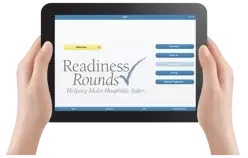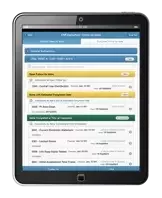
So, your facility has implemented a great electronic rounding system, and everyone is engaged and on board.
- Nursing is rounding on CAUTI, CLABSI, and general nursing practice.
- The Pharmacy is reviewing medication storage, and the Environment of Care team is actively performing audits in clinical and non-clinical areas.
- Patient experience is being corrected in real-time and everything is going swimmingly!
After your first month or two of consistent rounding, you get your first real look at meaningful, streamlined data and think… UH OH! Wait a minute!
You were sure your medications were labeled better than that…!
Surely there aren’t THAT many stained ceiling tiles…!
Whoa, is anyone labeling central line dressings????
Now that all this “valuable” empirical data is available,


Here are some suggestions to ready your organization:
1. Market your new process internally before it’s implemented.
2. Have open discussions with leaders and take their feedback and fears to heart.
3. Be sure you have a plan to the data for performance improvement.
4. The next step is to prepare leaders for data transparency.
Even a seemingly simple change like making a paper process “electronic” can be overwhelming. Be sure you have not only explained the new process and benefits, but also have listened to and considered feedback.
Concerns about staffing resources are valid! The return on investment or the time payoff on the back end must be embraced by leaders prior to the new process rolling out. That being said, the beauty of data transparency often isn’t fully understood until the first reports and dashboards are reviewed.
A quality digital rounding platform will allow easy visualization of top opportunities for improvement. Be ready to act on them!
Data transparency capability may be new to your organization. Suddenly managers, directors, VPs, and the C-Suite ALL know where the issues are within the organization. Prepare leaders for this “new world” of clarity by helping them appreciate the ability to observe real-time failure, improvement, and success.

Next, be sure to remind leaders, staff, and PI teams that, although the data itself is empirical, data equates to the safety of real living and breathing humans.
How to break bad news:
Here are some "pearls" heard from our Readiness Rounds' clients in referring to breaking "bad news”:
"The data is what it is. It doesn’t have feelings and it isn’t personal or punitive. The rounders do their jobs, the platform does its job, and the results speak for themselves."
"The patients represented by the data are human beings that deserve the best care and safest environment possible. Each checklist item means potential for success, harm, and satisfaction for our patients."\
"Data also equates to institution's financial status. In order to be sustainable, high-reliability organizations must reduce penalties, reduce hospital acquired infections, and eliminate systemic failures that cause harm. This means knowing where the opportunities for improvement exist."
"All the “little” things add up! When each level of the organization can see their specific successes and improvement opportunities, they can easily pinpoint what to keep doing and where change needs to occur. Continuing to share trended data allows for ongoing monitoring and answers the question, “Is what we are doing working?”
Overall, data transparency and sharing can be scary, but it is also incredibly valuable! Learn to embrace it and use the knowledge for positive change!

